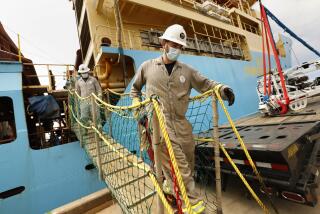Scientists drill beneath Dead Sea in search of priceless data
- Share via
Reporting from Dead Sea — If you thought you couldn’t get any lower than the Dead Sea, think again. You can go under it.
Scientists here are drilling 1,640 feet beneath the bottom of the Dead Sea, to a depth of more than 2,600 feet below sea level.
Rock samples that have been underwater for millions of years are likely to be better preserved, they say, than samples taken from under an exposed surface, which can be damaged by aridity and erosion.
As a result, the Dead Sea bore hole is expected to contain priceless information about the planet’s past and to offer insight on its future. Expectations are high that the lowest place on Earth can answer questions on climate change, earthquake risk and untapped natural resources.
Since the region was mentioned in biblical contexts that include Sodom and Gomorrah, the ruins of which some scholars believe are submerged under the Dead Sea, the $2.5-million project might also crack an ancient mystery or two.
It’s a massive undertaking. A unique rig was constructed and then towed more than 4 miles into the salty sea, where drilling will go on for 40 days and nights, perhaps appropriate for the region.
Forty scientists from six countries are taking part in the deep-drilling program, sponsored by the Israel Academy of Sciences and Humanities and the German-based International Continental Scientific Drilling Program, which conducts deep sea and lake drilling worldwide.
The samples are expected to provide a sort of tree-ring-style annual log, stretching over a half-million-year period, that will enable experts to say, for example, that “368,153 was a very rainy year,” says Zvi Ben-Avraham, head of the Minerva Dead Sea Research Center at Tel-Aviv University.
At a nearby laboratory, the rings are clearly visible through Plexiglas tubes containing the first samples. A pair of layers, brown and white, represent a normal year with a wet season and a dry one. Variations bear witness to drought, flood and trauma. “These are the pages of our history,” says Amotz Agnon of the Hebrew University of Jerusalem.
The Dead Sea — a lake, really — is what has remained for the last few million years of a series of ancient bodies of water in the Jordan Valley, although its current version is only 11,000 years old. It fills one of Earth’s deepest holes, located in a depression on the border between two tectonic plates forming part of the long Syro-African fault line. The plates are still moving. Small tremors are not infrequent, but Ben-Avraham says the region is relatively calm. The last big quake occurred in 1927.
Experts say the Dead Sea should provide invaluable historical data because the region served as a corridor through which humankind migrated from Africa.
Filled tubes are kept in a freezer outside an unassuming lab in Kibbutz Ein Gedi, in the hills above the water. Early batches have been passed through a scanner that buzzes and beeps while sending data to a computer.
More tubes lie on the floor of the lab, soon to be put through the machine. In one, a 4-inch stretch of mud reflects a century-long wet period around 400 years ago, in what is known as the Little Ice Age. Deeper samples should corroborate other documented events such as the volcanic eruption of Santorini about 3,500 years ago.
Data contained in these “archives,” as Moti Stein of the Geological Survey of Israel puts it, are of global importance. The data of past relations between two climate belts, the Mediterranean and the desert, will help prepare climate models in times of global warming and desertification, Stein says.
The Dead Sea itself is as unusual as the drilling project.
Fresh water flowing into the sea is trapped; with no outflow, the only way out is up. High evaporation rates in this hot, arid zone result in extreme hyper-salinity.
The buoyancy draws tourists who come for a float. Others are attracted by the purported cosmetic and healing properties of the minerals, fabled since antiquity, or simply for the striking landscape.
But the Dead Sea is in trouble. Receding about 3 feet a year, the water, pessimists warn, could soon vanish. Stein says the lake has naturally recovered from catastrophic aridity before.
But humans are playing a role. “We’re not helping,” says Michael Lazar, the marine geophysicist from the University of Haifa who manages the project.
Tectonic plates aren’t the only things grating against each other. There’s regional politics too. The Dead Sea fills an area shared by Israel, Jordan and the Palestinians. The site’s nomination for the Seven Wonders of the World competition was almost undone by conflicting political claims.
Though no Jordanian or Palestinian scientists were to be seen during a recent media tour of the site, organizers said the multinational project includes both. A project official said Arab scientists were keeping a low profile because of political sensitivities.
“The Dead Sea doesn’t belong to Israel, Jordan or the Palestinians,” Lazar said. “They’re in, and we’re happy to have them.”
Sobelman is a news assistant in The Times’ Jerusalem Bureau.





